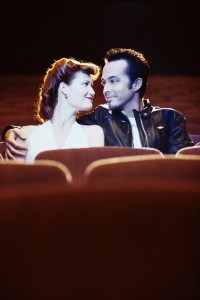- An essential component of every romance is bringing two unlikely people together. For example, your heroine may have a cheerful disposition while the hero has a serious or anxious personality. One may be rich, the other poor. One trustful, the other distrustful. One optimistic, the other hopeless. One of the characters could be a perfectionist, while the other is sloppy and clumsy. Personality differences between the couple creates conflict and drives the plot or story. Take the characters played by Meg Ryan and Tom Hanks in You Got Mail. Meg plays Kathleen Kelly, the sweet charismatic owner of a little bookstore called The Shop Around the Corner. Tom Hanks plays Joe Fox (even the name comes across as predatory), the ruthless businessman and owner of a chain of bookstores called Fox Books. Kathleen and Joe have fallen in love through anonymous emails and instant messages to each other online but hate each other in real life. Joe’s bookstore is moving into Kathleen’s neighborhood and threatens to shut down her shop. But when Joe learns Kathleen’s identity, he sets out to make her fall in love with him in real life. This leads us to opposing goals.
The opposing objective storyline:
- The opposing goal storyline may pit a couple against each other to complete a goal, but it also serves to bring them together. The couple may discover in the end that the goal is not as important as the other person or as important as their relationship. Using You Got Mail as another example, after Joe destroys Kathleen’s bookstore, forcing her to shut down, he not only feels guilty, but realizes he may have done irreparable harm to her emotionally since closing the bookstore forced her to mourn the loss of her mother ‘all over again’. Because he put his objective first, he stands very little chance of winning Kathleen over and must work overtime to gain her trust before he reveals his identity. In the movie Love and Basketball, Monica and Quincy (played by Sanaa Lathan and Omar Epps, respectively) have known each other since grade school and share a love of basketball. They’ve been competing against each other for most of their lives, striving to outdo each other’s accomplishments on court… until Monica and Quincy fall in love. After a bitter break-up and moving on to professional basketball careers, they lose passion for the sport without each other. This is an example of conflict, competition, and opposing goals bringing couples together.
Same team storyline:
In romance, couples sometimes work together. But even working together there is conflict since the parties may have opposite approaches to tackling a problem. For example, lawyers or often detectives trying to solve a mystery or a case. Or doctors and scientists working to cure a patient or disease. One could be methodical, the other unorthodox. Again, the key is conflict to keep audiences interested.
Tragic love stories: There are stories like Titanic that feature a couple who share a goal. Jack and Rose (played by Leonardo Dicaprio and Kate Winslet) tried to overcome the class differences that threatened to separate them. While Jack and Rose share an epic romance, Titantic wouldn’t fall into the “romance” genre, even though it’s a love story. Titantic, Romeo & Juliet, and similar stories should be categorized as dramas or tragedies for example, because of the unhappy, tragic endings. Other movies or books can be classified as romantic comedies (not necessarily a romance), among other types of stories.
As a friend once told me, “Every story is a love story,” which is true, but it doesn’t make it a ‘romance’, a unique (and sometimes formulaic) genre unto itself.
That being said, despite the guidelines governed above, writers should strive for a unique spin on the formula. Admittedly, my novels have had a discernible pattern, but also allows for my own unique stamp. For example:
1.) In my stories the couple may have known each other in their youth.
2.) One or both were “in love” during that time but due to an obstacle or some other challenge were unable to reveal their feelings. The couple experiences unrequited love until adulthood when the couple meets again on equal terms.
3.) They share a common goal, which serves to bring them together. They also share opposing goals which could potentially keep them are apart.
4.) Despite this, the couple will find a way to overcome whatever challenges or obstacles stand in the way of being together.
5.) In the end they are rewarded with unconditional love.
Romance writers go about their stories in different ways to achieve the same outcome. But it’s the journey that makes getting to the destination so much fun!
To learn about different romance literature genres and subgenres you can visit the Romance Writers of America’s web page to learn more (by clicking the link above).

